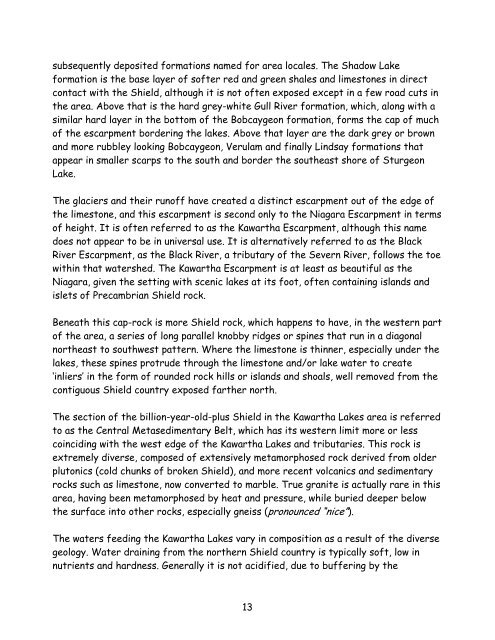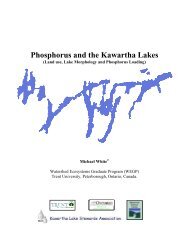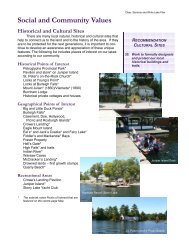Lake Water Quality 2006 Report - Lakefield Herald
Lake Water Quality 2006 Report - Lakefield Herald
Lake Water Quality 2006 Report - Lakefield Herald
You also want an ePaper? Increase the reach of your titles
YUMPU automatically turns print PDFs into web optimized ePapers that Google loves.
subsequently deposited formations named for area locales. The Shadow <strong>Lake</strong>formation is the base layer of softer red and green shales and limestones in directcontact with the Shield, although it is not often exposed except in a few road cuts inthe area. Above that is the hard grey-white Gull River formation, which, along with asimilar hard layer in the bottom of the Bobcaygeon formation, forms the cap of muchof the escarpment bordering the lakes. Above that layer are the dark grey or brownand more rubbley looking Bobcaygeon, Verulam and finally Lindsay formations thatappear in smaller scarps to the south and border the southeast shore of Sturgeon<strong>Lake</strong>.The glaciers and their runoff have created a distinct escarpment out of the edge ofthe limestone, and this escarpment is second only to the Niagara Escarpment in termsof height. It is often referred to as the Kawartha Escarpment, although this namedoes not appear to be in universal use. It is alternatively referred to as the BlackRiver Escarpment, as the Black River, a tributary of the Severn River, follows the toewithin that watershed. The Kawartha Escarpment is at least as beautiful as theNiagara, given the setting with scenic lakes at its foot, often containing islands andislets of Precambrian Shield rock.Beneath this cap-rock is more Shield rock, which happens to have, in the western partof the area, a series of long parallel knobby ridges or spines that run in a diagonalnortheast to southwest pattern. Where the limestone is thinner, especially under thelakes, these spines protrude through the limestone and/or lake water to create‘inliers’ in the form of rounded rock hills or islands and shoals, well removed from thecontiguous Shield country exposed farther north.The section of the billion-year-old-plus Shield in the Kawartha <strong>Lake</strong>s area is referredto as the Central Metasedimentary Belt, which has its western limit more or lesscoinciding with the west edge of the Kawartha <strong>Lake</strong>s and tributaries. This rock isextremely diverse, composed of extensively metamorphosed rock derived from olderplutonics (cold chunks of broken Shield), and more recent volcanics and sedimentaryrocks such as limestone, now converted to marble. True granite is actually rare in thisarea, having been metamorphosed by heat and pressure, while buried deeper belowthe surface into other rocks, especially gneiss (pronounced “nice”).The waters feeding the Kawartha <strong>Lake</strong>s vary in composition as a result of the diversegeology. <strong>Water</strong> draining from the northern Shield country is typically soft, low innutrients and hardness. Generally it is not acidified, due to buffering by the13





